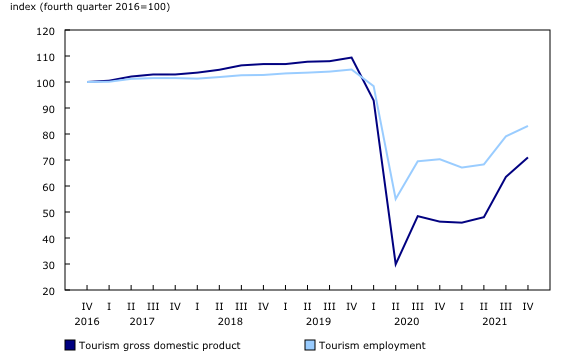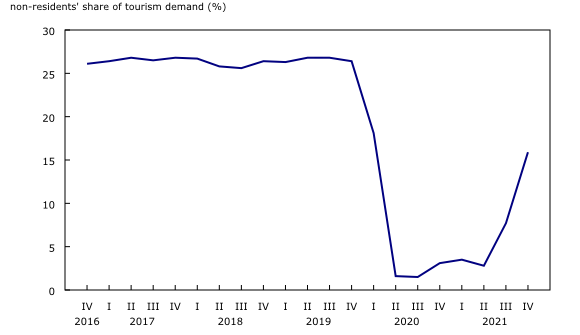National tourism indicators, fourth quarter 2021
Archived Content
Information identified as archived is provided for reference, research or recordkeeping purposes. It is not subject to the Government of Canada Web Standards and has not been altered or updated since it was archived. Please "contact us" to request a format other than those available.
Released: 2022-03-30
Tourism spending in Canada increased 8.7% in the fourth quarter, following a 29.3% rise in the third quarter. Annually, tourism spending rose 4.4% in 2021 after a 49.0% decline in 2020. Tourism gross domestic product (GDP) rose 11.9% in the fourth quarter of 2021 and was up 5.0% annually.
Despite the continued threat of COVID-19 and the emergence of new variants throughout 2021, increased vaccination rates throughout the year and resulting loosening of restrictions led to higher tourism spending in Canada in 2021. By the end of the third quarter, fully vaccinated travellers were allowed entry into Canada for non-essential travel. During the fourth quarter, the World Health Organization declared Omicron the latest variant of concern in late November. As a result, the Government of Canada reinstated certain travel requirements on December 21st, such as requiring a negative molecular test result for COVID-19 for all travellers arriving in Canada.
Growth in tourism spending in the fourth quarter was partly attributable to increased outlays in passenger air transport (+27.5%). This reflects the easing of travel requirements seen up until December 21st. Increased spending in accommodation services (+12.3%) further contributed to the quarterly rise. Tourism spending was 64.4% of what it was in the fourth quarter of 2019, prior to the pandemic.
Annually, tourism spending was up 4.4% in 2021, with the largest contributors being accommodation (+16.8%) and food and beverage (+13.3%) services. This more than offset the annual declines in passenger air transport (-17.8%) and travel services (-33.3%).
Tourism GDP grew 11.9% in the fourth quarter, following a 32.4% increase in the third quarter. Transportation (+47.7%) and accommodation services (+11.3%) were the greatest contributors to the growth in tourism GDP. Despite this increase, tourism GDP in the fourth quarter was 35.0% below pre-pandemic levels. With economy-wide GDP up 1.6% in the fourth quarter, tourism's share of GDP rose from 1.2% in the third quarter to 1.3% in the fourth quarter.
Annually, tourism GDP rose 5.0% in 2021, a similar rate as the overall economy (+4.6%), leaving tourism's share of GDP stable at 1.0% for the year. Accommodation services (+16.4%) contributed the most to the rise, which was partially offset by declines in transportation (-14.2%) and other tourism industries (-6.8%).
Employment attributable to tourism grew 5.1% in the fourth quarter, following a 15.8% increase in the third quarter. Food and beverage services (+4.8%) and accommodation services (+5.7%) were the largest contributors to growth in the fourth quarter.
Over the course of 2021, employment attributable to tourism grew 1.5%. Economy-wide employment was up 8.5%, resulting in the share of employment attributable to tourism declining from 2.8% in 2020 to 2.6% in 2021. The largest contributor to growth was food and beverage services (+8.1%). Air transportation (-22.5%) and travel services (-18.3%) were down in 2021, despite gains in the fourth quarter.
Tourism spending in Canada by Canadians decreases
Tourism spending in Canada by Canadians decreased 1.0% in the fourth quarter, as outlays on most products were lower. Increased spending on passenger air transport (+9.2%) partially offset the quarterly decline.
Annually, domestic tourism spending rose 5.0% in 2021. This was mainly attributable to more spending in accommodation services (+18.8%). Growth was partially offset by lower spending in passenger air transport (-19.0%).
Spending by international visitors continues to rise
Tourism spending by international visitors to Canada continued to recover in the fourth quarter (+124.5%), following a 250.5% increase in the third quarter. Accommodation services (+125.2%) had the greatest contribution to the growth in the fourth quarter, followed by passenger air transport (+150.7%).
Despite the very strong growth in the third and fourth quarters, spending by international visitors decreased 2.3% annually in 2021. The annual decrease in passenger air transport (-12.0%) was enough to offset growth in accommodation (+5.0%) and food and beverage (+3.9%) services. Overall, tourism exports in 2021 was 16.6% of what it was in 2019, pre-pandemic.
As a result of strong growth in the latter half of 2021, the exports share of tourism spending climbed to 15.9% in the fourth quarter, compared with 2.8% in the second quarter. Annually, the exports share of tourism spending fell to 8.3% in 2021, down from 8.9% in 2020 and down from 26.6% in 2019.
Sustainable development goals
On January 1, 2016, the world officially began implementing the 2030 Agenda for Sustainable Development, the United Nations' transformative plan of action that addresses urgent global challenges over the next 15 years. The plan is based on 17 specific sustainable development goals.
The national tourism indicators are an example of how Statistics Canada supports the reporting on the global goals for sustainable development. This release will be used in helping to measure the following goal:

Note to readers
Growth rates for tourism spending and gross domestic product (GDP) are expressed in real terms (that is, adjusted for price changes), using reference year 2012, as well as adjusted for seasonal variations, unless otherwise indicated.
Employment data are also seasonally adjusted.
Tourism's share of economy-wide employment is calculated using seasonally adjusted values.
For information on seasonal adjustment, see Seasonally adjusted data – Frequently asked questions.
Associated percentage changes are presented at quarterly rates unless otherwise noted.
Economy-wide GDP is obtained from table 36-10-0104-01. Economy-wide employment is obtained from table 36-10-0207-01.
Non-tourism industries, also referred to as other industries, are industries that would continue to exist in the absence of tourism. For example, the crop production and petroleum refineries industries produce products purchased by tourists. However, neither would cease to exist in the absence of tourism. Tourism GDP takes into account the production of these products purchased by tourists.
Non tourism products, also referred to as other products, are products for which a significant part of its total demand in Canada does not come from visitors, such as groceries, clothing and alcohol bought in stores.
With the fourth quarter 2021 release of the national tourism indicators, all data from the first quarter of 2018 to the third quarter 2021 have been revised.
Revisions over the 2020 to 2021 period are expected to be higher than normal due to the volatile economic situation, particularly for the tourism sector.
The national tourism indicators are funded by Destination Canada.
Next release
Data on the national tourism indicators for the first quarter of 2022 will be released on July 6.
Products
The data visualization product "Provincial and Territorial Tourism Satellite Account," which is part of Statistics Canada – Data Visualization Products (71-607-X), is available.
The Economic accounts statistics portal, accessible from the Subjects module of the Statistics Canada website, features an up-to-date portrait of national and provincial economies and their structure.
The Latest Developments in the Canadian Economic Accounts (13-605-X) is available.
The User Guide: Canadian System of Macroeconomic Accounts (13-606-G) is available.
The Methodological Guide: Canadian System of Macroeconomic Accounts (13-607-X) is available.
Contact information
For more information, or to enquire about the concepts, methods or data quality of this release, contact us (toll-free 1-800-263-1136; 514-283-8300; infostats@statcan.gc.ca) or Media Relations (statcan.mediahotline-ligneinfomedias.statcan@statcan.gc.ca).
- Date modified:






